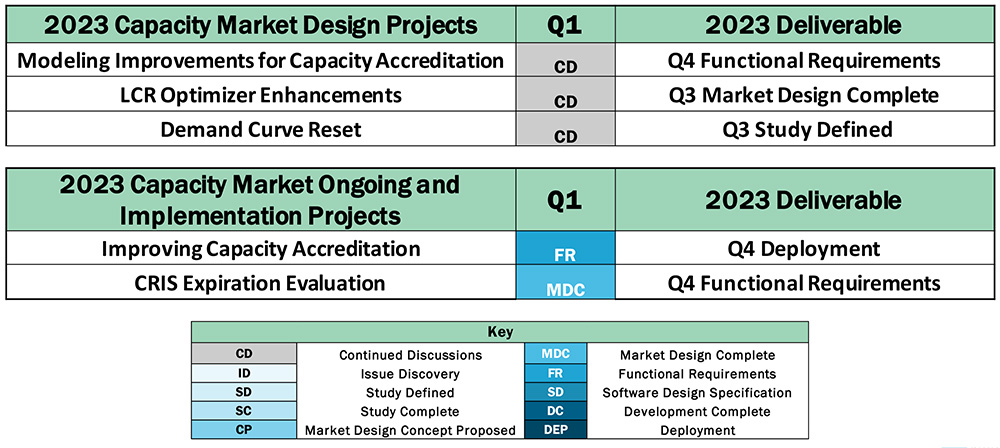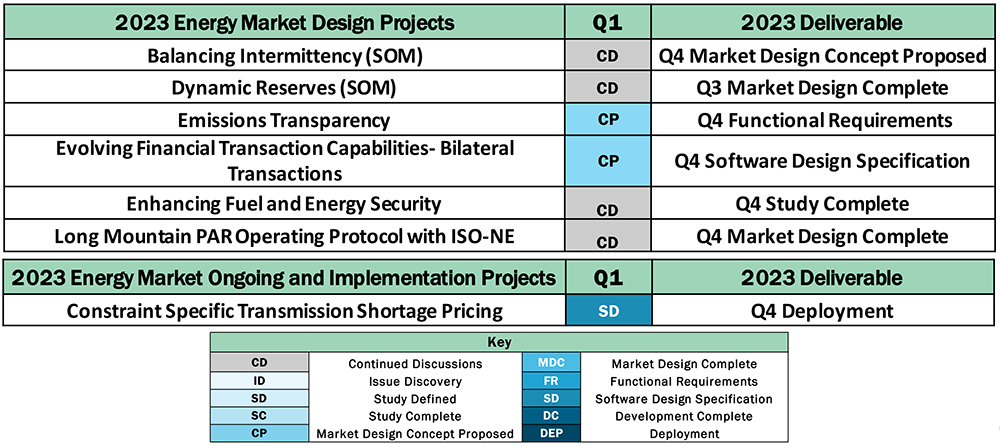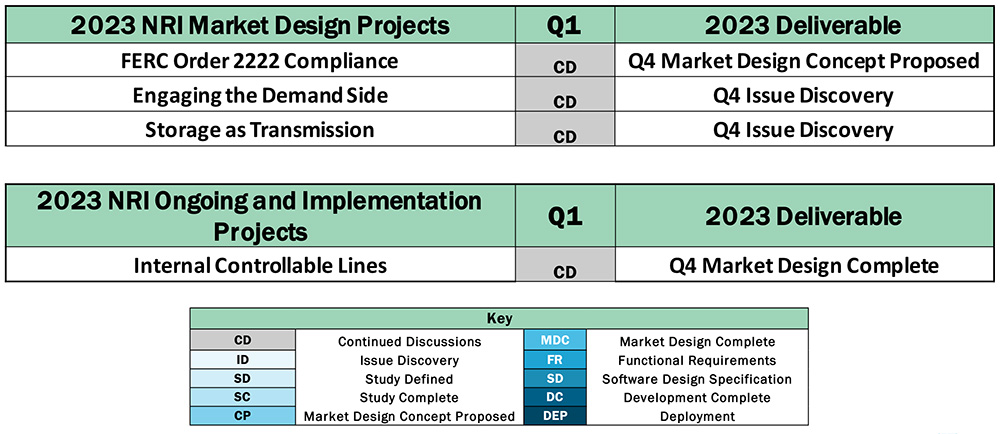RTO stakeholders last week presented FERC with a cornucopia of suggestions for dealing with electrification and the increasing penetration of variable resources, some supportive of grid operators’ actions, others calling them discriminatory.
Last April, FERC ordered CAISO, ISO-NE, MISO, NYISO, PJM and SPP to report on how system needs are changing with their shifting resource mixes and how they will meet them. (See FERC Asks RTOs for Plans on Changing Market Needs.)
On Thursday, 19 groups and companies filed comments responding to the RTOs’ reports, which were filed in October (AD21-10).
Most of last week’s responses supported FERC’s position that it would not propose a “generic solution” across the RTOs/ISOs because of the diversity of the regions’ generation mixes. But several commenters said the commission should provide guidance to RTO efforts to develop new products and market rules.
After four technical conferences in 2021 and dozens of comments, the commission has built a large record in the wide-ranging docket, which included discussions of resource adequacy, interregional planning, NERC reliability standards and distributed energy resources.
The first technical conference in the docket in March 2021 focused on capacity markets in PJM, ISO-NE and NYISO. (See PJM MOPR in the Crosshairs at FERC Tech Conference.) A second conference focused on ISO-NE’s markets. (See Regulators, ISO-NE Discuss Market Changes at FERC Tech Conference.) In September and October 2021, the commission held conferences on energy and ancillary services (E&AS) markets, with a focus on the need for flexible ramping products to supplement wind and solar generation. (See Flexible Ramping Grows as Ancillary Service and Stakeholders Ask FERC to Support E&AS Market Changes.)
The only commission actions to come out of the fact-finding thus far have been orders to essentially eliminate the minimum offer price rule in PJM and ISO-NE. Those votes came with a 3-2 Democrat-controlled commission. With the Jan. 3 departure of Chair Richard Glick, Acting Chair Willie Phillips and Democrat Allison Clements will be unable to approve any rule changes without winning over Republican James Danly or — more likely — Mark Christie.
Deference vs. Standardization
The Edison Electric Institute said FERC should defer to the RTOs. “It is critical that RTOs and ISOs be allowed to identify issues and propose solutions to changing system needs through their stakeholder processes,” EEI said. “It is especially important that the commission allow the existing reform efforts described in the RTO/ISO reports to play out.” EEI also urged the commission not to consider action on interregional transfer capability in the docket, saying docket AD23-3, the subject of a FERC workshop in December, was a more “appropriate” venue. (See FERC Considers Interregional Transfer Requirements.)
In contrast, the American Clean Power Association, American Council on Renewable Energy and the Solar Energy Industries Association — filing jointly as “Clean Energy Associations” — called for standardization across RTOs. “Competition in the markets will be improved if the RTOs/ISOs adopt common terms, products, protocols, and review measures,” they said.
Constellation Energy (NASDAQ: CEG) said ISO-NE could use FERC guidance in designing operating reserves and related products, citing the RTO’s statement that it is difficult for RTOs and their stakeholders “to make progress … in the absence of proactive guidance from the commission.”
Shell (NYSE:SHEL) — which owns Shell New Energies U.S., developers of the Atlantic Shores and Mayflower Wind offshore wind projects, and Savion, a utility-scale solar and energy storage developer — said FERC “must provide an overall framework to both ground and discipline RTO/lSO efforts to ensure reliability is maintained” in light of state actions to address climate change.

“Addressing one-off questions on a stand-alone basis — such as whether locational-based marginal pricing for energy markets can continue; whether co-optimized ancillary service markets with opportunity cost pricing will deliver the right resources; or even whether capacity markets serve as the right platform for providing the ‘missing money’ needed to meet resource adequacy challenges — will be woefully insufficient,” it said. “Issuing a policy statement that defines general principles without prescribing set solutions will provide cohesion but permit the necessary flexibility for each RTO/ISO to efficiently and effectively meet its respective regional needs.”
Advanced Energy United, formerly Advanced Energy Economy, said FERC should “engage critically” on the issue of capacity accreditation and “proactively engage on flexibility” through new energy and ancillary service products and evaluation of existing market rules.
The group also called for the commission to finalize its rulemakings on transmission planning, cost allocation and generator interconnection; complete rulings in Order No. 2222 dockets on removing barriers to DERs and look for ways to increase the roles of DERs and flexible demand; and improve wholesale-retail coordination.
Generation Dispatch
Constellation said RTOs should be more transparent about their out-of-market actions.
“There is little understanding — by the market participants who are most affected — of RTO out-of-market actions such as manual unit commitments, posturing and load biasing; the frequency or magnitude of these activities; the circumstances that necessitate them; or, importantly, how these ‘practice[s] … affect … rates,’” it said. “Most of these out-of-market actions are taken in control rooms and are hidden from market participants.”
The Clean Energy Associations called for increased use of probabilistic unit commitment, saying it would produce more efficient, lower-risk operations. “For example, if forecasts indicate a significant chance of both very high load and very low renewable output, operators will likely want to commit more resources. However, because those risks are not reflected in the median value for either forecast, current deterministic methods do not automatically incorporate them into commitment decisions, forcing operators to attempt to subjectively incorporate them.”
Capacity Markets, Ancillary Services
R Street Institute called for less reliance on capacity markets and more demand-side participation, which it said is “chronically underutilized.”
“The most efficient and accurate price signals come from energy and ancillary service markets, where the reflection of actual conditions occur on a granular basis, unlike the more administrative constraints at broader estimation of transmission constraints in capacity markets,” it said.

Environmental groups, including Earthjustice, Natural Resources Defense Council, Sierra Club, Sustainable FERC Project and the Environmental Defense Fund, also called for more demand-side solutions. “Resources such as demand response, electric storage and distributed energy resources can go a long way to ameliorate the resource adequacy shortfalls that some of the RTOs/ISOs complain of in their reports.”
The Clean Energy Associations cited PJM in calling for “reducing over-procurement of capacity,” and urged the commission hold a dedicated technical conference on capacity accreditation.

They also said energy market price caps should be increased to reflect the true value of lost load. “CAISO, MISO and PJM all have relatively low price caps in their energy markets, which can mute the incentive for performance during periods of extreme scarcity and result in under-investment in flexible generation that contributes to resource adequacy,” they said. “Low price caps can also cause unintended consequences in energy markets. For example, energy market price caps in CAISO caused many storage resources to prematurely discharge during early afternoon periods in the September 2022 heat wave because once prices hit the $2000/MWh cap, storage resources had no incentive to retain their state of charge even though it was known that net load would be even higher later in the afternoon and evening.”
They said FERC should also consider making planned generator and transmission outages transparent “so they are priced in the market.”
RTOs could also play a greater role in coordinating transmission and generation outages to reduce congestion costs, they said. MISO’s Independent Market Monitor has recommended such a change, noting that: “ISO-New England does have the authority to examine economic costs in evaluating and approving transmission outages, which has been found to have been very effective at avoiding unnecessary congestion costs.”
Broaden the Inquiry?
The Electricity Consumers Resource Council (ELCON), which represents large industrial energy users, was among commenters that called for FERC to broaden its inquiry.
“This proceeding is a perfect opportunity to explore whether — and if so, how — the policy goals outlined by the Commission 23 years ago in Order No. 2000 have been achieved,” ELCON said. “At this point, the track record with existing institutions is nothing if not sufficiently long. FERC has employees on staff who were born, raised and earned graduate degrees in the time since Order No. 2000 was issued.”
The Clean Energy Buyers Association, which represents 89 Fortune 500 companies, said it agreed with Commissioner Christie that the commission should expand the scope of its inquiry beyond E&AS markets, “including requiring RTOs/ISOs to address whether intermittent and hybrid resources are compensated appropriately to ensure reliability.”
Advanced Energy United said the commission should require the RTOs to update their reports on modernizing electricity market design annually. “Having year-over-year data and insights from the RTOs/ISOs will give the commission insight into emerging grid and market changes and a deeper understanding of long-term trends.”
R Street Institute challenged the presumption that RTOs will continue in their existing form, reiterating its request, with ELCON and others, for a congressional study of the electric power industry and its regulation. “The benefits of wholesale competition have not always been clear for retail consumers, sometimes because of unmitigated market power but more often because of faulty retail regulation,” R Street said.
Gas-electric Coordination
The Electric Power Supply Association asked FERC to redouble efforts to improve gas-electric coordination, warning “we are approaching a precipice in terms of system reliability which must be acknowledged.
“The need to reform power markets to address planning parameters, operational issues and flexibility needs is no longer a theoretical exercise but an imminent concern that must be addressed. Additionally, the lessons of Winter Storms Uri in 2021 and Elliott just a few weeks ago shine a bright and unavoidable light on ongoing coordination problems between the electricity and natural gas systems, which are likely to intensify as the system becomes increasingly dependent on dispatchable resources including natural gas-fired generation,” EPSA said.
Electric-gas coordination has been an issue in PJM since at least the 2014 polar vortex, when the RTO saw more than 20% of its gas-fired generation unavailable. The high outage rate was supposed to be solved by PJM’s Capacity Performance rules, yet the RTO saw similar rates of natural gas plant outages over the Christmas holiday. (See PJM Gas Generator Failures Eyed in Elliott Storm Review.)
“The issues raised by the challenges of gas-electric coordination are complex and implicate long-held practices in both industries, contributing to the reluctance to change or reform from either side. There are reforms that can be undertaken in electricity markets to address natural gas supply issues and availability. Notably, however, those power market reforms likely need to be matched in some manner by either reforms or adjustments on the natural gas side.”
 Days per month of natural gas supply risk under deep decarbonization in New England | ISO-NE
Days per month of natural gas supply risk under deep decarbonization in New England | ISO-NEEPSA said the discussions should go beyond weather to also ensure sufficient gas-fired capacity to respond to ramping needs. “The broader discussion must evaluate the need for additional supply and transportation capacity to ensure units can run when called and not be restricted by a system that is not expanding with the increase in demand,” it said.
EPSA said solutions could require “reimbursement for the cost of fuel in a manner not provided for today.”
EEI suggested the commission convene a technical conference to discuss the issue.
Barriers to Entry
Environmental groups including Earthjustice, Natural Resources Defense Council, Sierra Club, Sustainable FERC Project and the Environmental Defense Fund said the RTO/ISO reports “fail to address barriers to entry that resources face in attempting to gain access to markets.”
“The commission should require that each RTO/ISO focus on improving existing ancillary services prior to identifying new services or expanding the scope of market,” they said. Among the improvements the groups would like: shortening the durational requirements for eligibility to provide ancillary services and identifying stacking techniques for battery storage and hybrid resources. They also called for development of new ancillary services such as market-based fast frequency response and primary frequency response products and for splitting regulation services into upward and downward ramping products.
They said FERC should open proceedings under Section 206 of the Federal Power Act over MISO’s refusal to let dispatchable intermittent resources (DIRs), such as wind and solar, sell ancillary grid services in the operating reserves markets. They said MISO’s report “understates the ancillary services contributions of inverter-based resources while overstating the contributions of legacy resources.”
“It is well-accepted that DIRs and hybrid resources are technically capable of providing these services, and often more quickly and accurately than traditional thermal resources. However, MISO’s blanket prohibition is locking these resources out of the market, unnecessarily removing tools at MISO’s disposal to lower ancillary services costs while simultaneously increasing reliability,” they said. (See MISO Plans to Bar Intermittent Resources from Ramp Capability.)
The Clean Energy Associations said RTOs/ISOs should not interfere with market participants’ use of their commitment and dispatch preferences, including giving battery storage operators the option of managing their state-of-charge at all times.
“Today wind and solar may or may not be the most cost-effective resources to provide certain services given the opportunity cost of curtailing renewable generation,” they acknowledged. “However, as the renewable penetration increases, curtailment will increase, and the opportunity cost of foregone energy production will decline so that renewables may increasingly become cost-effective sources of ancillary services and flexibility in the upward as well as downward direction.”
Saving Coal
Coal industry group America’s Power asked the commission to require RTOs pay coal generators to keep operating to reflect the reliability benefit of their dispatchability and on-site fuel storage. “We respectfully urge the commission to require RTOs to value the needed attributes to mitigate the impacts of further retirements until global reforms can be developed and implemented,” it said.
Tom Stacy and George Taylor, who have consulted with America’s Power, filed comments calling themselves “Independent Ratepayer Advocates,” in which they said variable energy resources should not be granted interconnection rights unless their sites also include a dispatchable resource or storage. “The commission should resist the desire of VER investors — or anyone else — to continue to expand their market share while avoiding costs their resources create,” they said.


